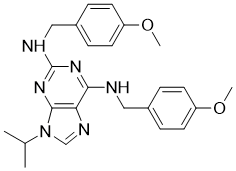Myoseverin is a reversible fission inducer of multinucleated myotubes into mononucleated fragments. It affects the expression of multiple growth factor, immunomodulatory, extracellular matrix-remodeling, and stress response genes, which is consistent with the activation of pathways related to tissue regeneration and wound healing.
Physicochemical Properties
| Molecular Formula | C24H28N6O2 |
| Molecular Weight | 432.5181 |
| Exact Mass | 432.227 |
| Elemental Analysis | C, 66.65; H, 6.53; N, 19.43; O, 7.40 |
| CAS # | 267402-71-1 |
| Related CAS # | 267402-71-1 |
| PubChem CID | 4273 |
| Appearance | Off-white to light yellow solid powder |
| Density | 1.2±0.1 g/cm3 |
| Boiling Point | 661.3±65.0 °C at 760 mmHg |
| Melting Point | 108 °C |
| Flash Point | 353.7±34.3 °C |
| Vapour Pressure | 0.0±2.0 mmHg at 25°C |
| Index of Refraction | 1.632 |
| LogP | 3.04 |
| Hydrogen Bond Donor Count | 2 |
| Hydrogen Bond Acceptor Count | 7 |
| Rotatable Bond Count | 9 |
| Heavy Atom Count | 32 |
| Complexity | 551 |
| Defined Atom Stereocenter Count | 0 |
| SMILES | O(C([H])([H])[H])C1C([H])=C([H])C(=C([H])C=1[H])C([H])([H])N([H])C1=C2C(=NC(N([H])C([H])([H])C3C([H])=C([H])C(=C([H])C=3[H])OC([H])([H])[H])=N1)N(C([H])=N2)C([H])(C([H])([H])[H])C([H])([H])[H] |
| InChi Key | IDCOTQWQVPRTNK-UHFFFAOYSA-N |
| InChi Code | InChI=1S/C24H28N6O2/c1-16(2)30-15-27-21-22(25-13-17-5-9-19(31-3)10-6-17)28-24(29-23(21)30)26-14-18-7-11-20(32-4)12-8-18/h5-12,15-16H,13-14H2,1-4H3,(H2,25,26,28,29) |
| Chemical Name | 2-N,6-N-bis[(4-methoxyphenyl)methyl]-9-propan-2-ylpurine-2,6-diamine |
| Synonyms | Myoseverin |
| HS Tariff Code | 2934.99.9001 |
| Storage |
Powder-20°C 3 years 4°C 2 years In solvent -80°C 6 months -20°C 1 month |
| Shipping Condition | Room temperature (This product is stable at ambient temperature for a few days during ordinary shipping and time spent in Customs) |
Biological Activity
| Targets | microtubule |
| References |
[1]. Myoseverin, a microtubule-binding molecule with novel cellular effects. Nat Biotechnol. 2000;18(3):304-308. |
Solubility Data
| Solubility (In Vitro) |
DMSO: 87~250 mg/mL (201.2~578.0 mM) Ethanol: ~22 mg/mL (~50.9 mM) |
| Solubility (In Vivo) |
Solubility in Formulation 1: 2.08 mg/mL (4.81 mM) in 10% DMSO + 40% PEG300 + 5% Tween80 + 45% Saline (add these co-solvents sequentially from left to right, and one by one), suspension solution; with sonication. For example, if 1 mL of working solution is to be prepared, you can add 100 μL of 20.8 mg/mL clear DMSO stock solution to 400 μL PEG300 and mix evenly; then add 50 μL Tween-80 to the above solution and mix evenly; then add 450 μL normal saline to adjust the volume to 1 mL. Preparation of saline: Dissolve 0.9 g of sodium chloride in 100 mL ddH₂ O to obtain a clear solution. Solubility in Formulation 2: 2.08 mg/mL (4.81 mM) in 10% DMSO + 90% (20% SBE-β-CD in Saline) (add these co-solvents sequentially from left to right, and one by one), suspension solution; with ultrasonication. For example, if 1 mL of working solution is to be prepared, you can add 100 μL of 20.8 mg/mL clear DMSO stock solution to 900 μL of 20% SBE-β-CD physiological saline solution and mix evenly. Preparation of 20% SBE-β-CD in Saline (4°C,1 week): Dissolve 2 g SBE-β-CD in 10 mL saline to obtain a clear solution. Solubility in Formulation 3: ≥ 2.08 mg/mL (4.81 mM) (saturation unknown) in 10% DMSO + 90% Corn Oil (add these co-solvents sequentially from left to right, and one by one), clear solution. For example, if 1 mL of working solution is to be prepared, you can add 100 μL of 20.8 mg/mL clear DMSO stock solution to 900 μL of corn oil and mix evenly. (Please use freshly prepared in vivo formulations for optimal results.) |
| Preparing Stock Solutions | 1 mg | 5 mg | 10 mg | |
| 1 mM | 2.3120 mL | 11.5602 mL | 23.1203 mL | |
| 5 mM | 0.4624 mL | 2.3120 mL | 4.6241 mL | |
| 10 mM | 0.2312 mL | 1.1560 mL | 2.3120 mL |
